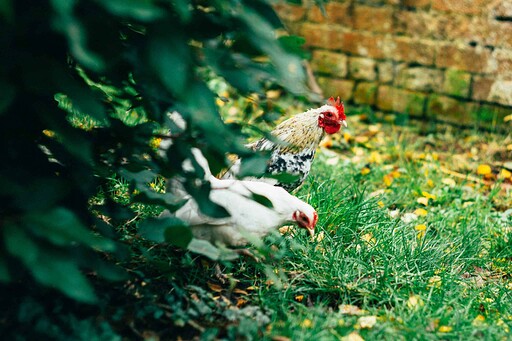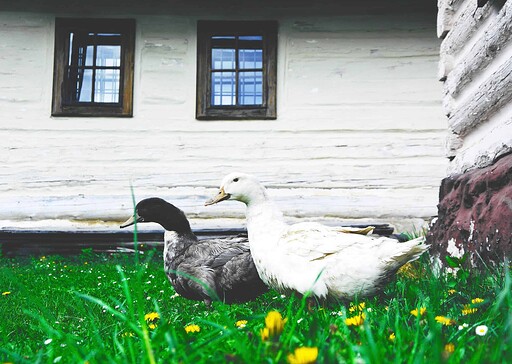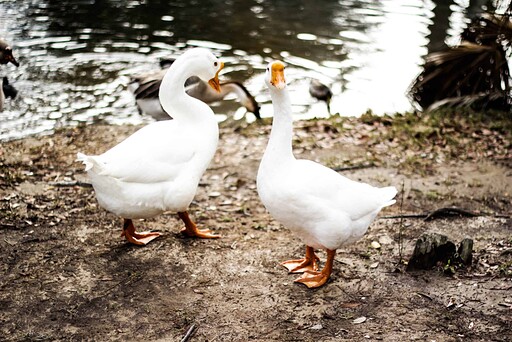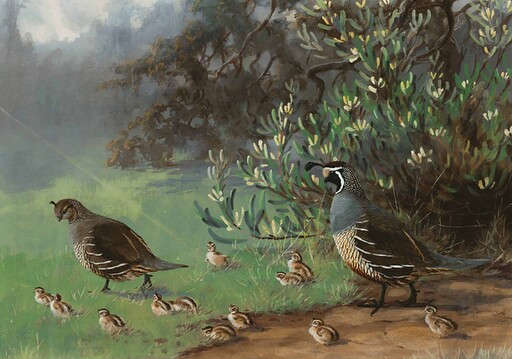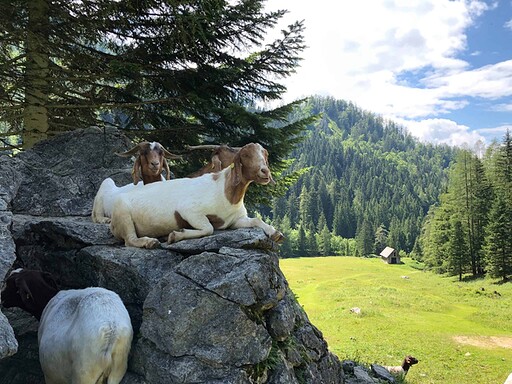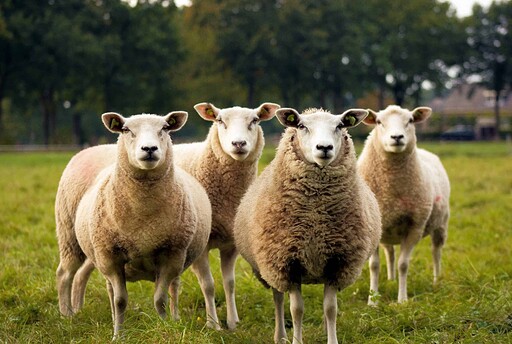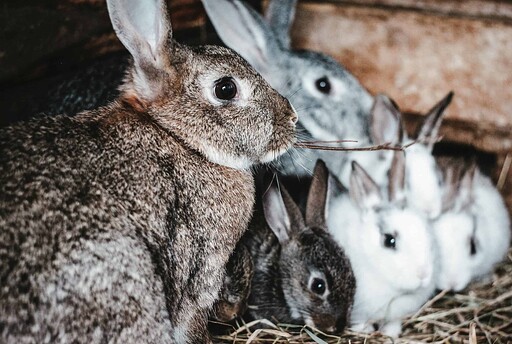A lot of people who are interested in raising farm animals feel daunted by the task, especially if they don’t have a lot of acreage. But there are plenty of livestock options out there for those with limited space.
In this article, I’ll discuss the pros and cons of raising various smaller types of livestock.
Raising livestock is not a decision that should be made without any significant consideration. Animals require regular care and attention. Above all else, you want to be humane in how they are treated and in giving them acceptable quality of life – which takes devoted care and attention. It can be a challenge to find someone to care for your animals the way you do should you have to go away on business or want to take a vacation with your family.
Chickens
Pros
- Easy to get started (Adam calls them the "gateway drug" to backyard animals)
- Provide meat (broilers) and eggs (layers)
- A natural solution for processing most of your family's food scraps
- Eat a lot of insect and worm pests that can cause trouble in your garden
- Kids can easily care for them
- Provide valuable protein on little feed
- Their manure can be used (with care) as fertilizer
- Have to be contained unless you are okay with them scratching up gardens and flower beds. Movable bottomless pens are often the solution.
- Roosters are loud and sometimes aggressive.
- Egg production decreases in winter and after three years of production.
Ducks
Pros
- Like chickens, they eat a lot of insect and worm pests that can cause trouble in your garden
- Fun to be around, and they make great pets
- Less likely to hurt you even if they do get mad. A peck from a duckbills hurts less than one from a chicken beak.
- Very friendly and good with other birds
- Provide meat and eggs
- Need substantial amounts of fresh and clean water daily to avoid health issues
- Defecate a lot. Duck feces can be a big problem if you confine ducks in a small space.
- Will eat small fish larvae, frog eggs, etc. If you have a pond, you may need to keep ducks out of it at crucial times if you want a large population of frogs or toads.
- Prone to predation. Ducks are very slow, and domestic ducks cannot fly well enough to get out of danger.
- Ducs can be very loud, especially at night and during the mating season.
Geese
Pros
- Produce larger eggs than chickens and ducks
- More meat on a dressed bird than a chicken or duck
- Excellent at weeding pastures and yards.
- Can survive on mostly grass with very little feed during the growing season.
- Large enough to defend themselves or get away from some predators
- Very prone to predators when sitting on nests.
- Crows love to attack their nests when they leave them briefly.
- More aggressive than other birds. Males can be particularly hostile during the breeding season.
- Large enough to hurt adults and children. If you have small children, you need to be with them when around geese.
- Tend to bully other birds more. Ducks learn to hang out but avoid physical contact. Chickens usually get picked on more.
- Very loud when disturbed or being fed. Geese will likely lead to noise complaints if you live in a place with neighbors close by. There is no way to train a goose to be quiet.
Quail
Pros
- Small and very quiet.
- They are kept in cages. Quail will leave if they get loose. You can keep a lot of quail in a small space.
- Provide gourmet small eggs and meat for your table.
- Eggs and meat fetch a high price at farmer markets and specialty shops.
- Manageable for those that work outside the home.
- Raising quail is an excellent way to utilize a small space on your property.
- You have to buy all of their food. It is not feasible to sustain them without a lot of outside inputs.
- Need cages with very fine mesh. Quail can escape through mesh openings that chickens can't.
- Cages must be managed well so that waste is not an issue.
- You have to butcher a lot of small birds, which can be time-consuming, for the amount of meat you get.
Goats
Pros
- Will eat practically anything. They are great for clearing out areas that seem impassable to humans.
- Hardy. Goats do well at a variety of temperatures. For hot climates, they are a better choice than sheep.
- Produce a lot of offspring.
- Delicious meat. If you like venison, you will like goat. A lot of people have a hard time telling the difference when it is cooked similarly.
- Easy to butcher and dress out.
- Very difficult to keep in a fence. An excellent fence is a must if you want to keep goats.
- Most goats are naturally horned. Horns can be dangerous. They like to use their horns to assert themselves.
- Smart enough to cause a lot of trouble.
- Aggressive at feeding time. Goats are very pushy.
- Love to escape if the pasture is greener on the other side of the fence. The harder forage is to get to, the more attractive it seems to them.
Sheep
Pros
- Can be very docile.
- Less mischievous than goats.
- Not as food aggressive.
- Very good at foraging and finding things to eat during the winter months.
- Do well in colder climates.
- Provide meat and fiber.
- Easy to sell as pets
- Females are hornless. There are some breeds where the males are naturally hornless too.
- Lambs are not as hardy as baby goats.
- More vulnerable to predators due to lack of horns.
- Most sheep have to be sheared once a year.
- Raw wool does not fetch a good price, and the market for processed yarn is very competitive.
- Shearing costs a lot if you don't do it yourself. It is very time-consuming for a beginner.
Rabbits
Pros
- Produce a lot of meat in a short time.
- Require little space.
- You can supplement their diet with garden waste and household vegetable scraps.
- Can be raised in cages that have wire on the bottom that grass can poke through. This is known as a rabbit tractor.
- Provide meat, fur, and they can be sold as pets.
- Will dig out of cages that are not adequately made or secured.
- They can scratch you a lot. They have incredible strength in their back legs.
- Very vulnerable to predators. Skunks and opossums are a big problem in rural and urban areas.
- Some people have a more challenging time butchering rabbits than other animals because they are considered very cute.
Mini livestock and small heritage breeds are not the same things.
Some breeds are naturally small, and others have been bred down to a smaller size. A lot of mini livestock carries an actual dwarf gene. This can actually cause problems in many cases.A significant disadvantage of mini cows, for example, is that you can only breed them to another mini. The cost for minis is much higher than a full-sized or naturally small breed of cattle. Artificial insemination services can take care of breeding for you, but the fees can add up. There is no guarantee that artificial insemination will work the first time. You have to buy semen and pay a professional to store it and come out when your cow is in season.
Some older or rarer breeds of livestock are naturally smaller. The Dexter cow is an excellent example of this. Of course, rarer means costlier.
Sometimes you may read a breed description only to find it is very misleading. Unfortunately, in the United States, breeders have not maintained acceptable breed standards. The result is livestock that gets to be much larger than what you would expect.
My husband and I used to raise Dexter cattle. The breed standard for a bull is under 1,000 lbs. It was not uncommon to see people winning prizes at shows for bulls that weighed as much as 1,500 lbs. Female Dexter’s are supposed to be under 750 lbs. I am not saying that no good stock exists, merely that you must be very careful when choosing your breeder.
Angus cattle, perhaps a better-known breed these days, used to be on the smaller side. But they have been bred up to a much larger size, too.
Avoid animal fads. They can cost you a lot of money and time.
Every once in a while, an animal fad takes off.Animals that are meant to be pets are particularly susceptible to being a market loss. This is at least in part due to the fact that they have no value as productive meat or egg animals. If a fad breed can at least be used to provide food, then you have more protection. But you still might experience a large loss.
Animal fads operate a lot like pyramid schemes. Those that win big with fad animals tend to be a select few breeders that get in and get out of the market fast Market saturation is a major factor.
Mini horses are an excellent example of this. At one point, these cute little horses were selling for $1,000 each to people that thought they could never have a horse or provide one as a pet to their child. Not long after that, you couldn’t sell one for $100. Plenty of people bought breeding stock and lost a lot of money finding out that people wouldn’t buy them for a price that came anywhere close to covering the expenses of keeping their breeders.
Mini pigs are a more recent fad animal. Small pigs have been popular in other countries for many years since they can be raised in small spaces and still provide a lot of meat for the table. Unfortunately, what’s sold as a ‘mini’ pig in the US gets much larger than what people realize. Pigs are generally big animals, so the term ‘mini’ can be quite misleading. The pig you think will top off at 100 lbs will likely be 200 lbs or more.
How many animals can your property support?
Stocking rates for livestock depend on a lot of factors and there's no one-size-fits-all guidance that works for everyone's situation.Here are a few questions to ask yourself to determine how many animals you can support on your property.
Remember that it’s best to start on the lower end of what you think you’ll be comfortable with until you gain some experience and see how things actually go on your property:
- How much supplemental feed are you willing to buy? If you're not relying entirely on your own pastures and grassy areas and purchasing more feed, then you can support more. But your overall expenses will be higher.
- How much time do you have to dedicate to care? Will you butcher and process meat at home or will you be paying someone else to do at least part of the butchering and processing?
- What is the size of the spaces you are willing to dedicate to livestock? Do you still want to have a medium to large yard? Do you need space for gardens?
- How good of a fence are you willing to invest in? What is your plan for maintaining your fences?
- Does your property have a lot of high-quality forage? Pastures can be improved over time if they're not overgrazed. So even if you start out with lower quality grasses and forage, you may be able to support more animals later on.
Butchering
You will inevitably have extra animals to sell or butcher at some point unless you're just keeping female animals (e.g. hens).Selling your male livestock is an option. But it doesn’t always work out. You’re usually better off butchering at least a few.
Getting over the squeamishness of taking an animal’s life yourself and breaking the carcass down is more challenging for some people than others. The key is to take your time and not be too hard on yourself if you gag a little the first few times.
Some animals smell worse than others when you are butchering. I would rather butcher out an 800 lb hog than 20 chickens. Believe it or not, chickens are smellier if you raise your pigs in a clean environment.
It helps to have someone that is experienced help you butcher the first few times. In some areas, some farms offer classes on basic butchering. YouTube is a treasure trove of “how to” videos on this, too.
Over the years, my husband and I have shown a few people how to butcher. One of the biggest challenges is getting people to realize that they won’t be good at it right away. Guess what? No one is!
The first time Matt and I butchered chickens, it took us all day to get six done. After some improvements in equipment and butchering a few more times, we could process up to 40 in about 5 hours.
Set small goals for the first time. Don’t expect to get a whole pig done in 3 hours the first time.
Emotions
Some folks get very emotional about taking the life of an animal. If you butcher enough, you get more hardened.I think it helps realize that if you eat meat, someone else has been doing this for you for a long time. You may be playing a more distant role, but you are a player in taking an animal life regardless. In most cases, the animals you raise are going to have led a much better life than those in factory farms and feedlots, and they will meet a swifter end.
When we butcher pigs, they never know what is coming. I cannot say that for industrial agriculture, where things are mechanized and animals can sense something, is very wrong.
Be realistic about the cost of food and housing for your livestock.
The cost of feeding your livestock will vary a lot based on how much you can provide from your property, how many animals you keep per acre, and the quality of the feed. Another main factor is your regional climate. If you have a short growing season, you will have to feed more to compensate for long winters.Some animals can live mostly on grass if they have enough of it, while others like chickens and quail need practically all their food bought.
Storage of feed is another factor to consider. You need a space that protects from moisture and varmints like opossums, raccoons, squirrels, and rodents.
Livestock need shelter but perhaps not as much as you think. It is easy to overbuild barns for animals. In the mountains of western North Carolina, barns are well ventilated. Part of the reason is to provide a cooler and shadier spot in the Spring and Summer. The other reason is that animals in barns with poor ventilation can develop respiratory problems, including pneumonia. A good three-sided loafing shed is about right. Perhaps half the front closed in if you want a stall or more protected area for very young animals.
Some old breeds of livestock like Shetland sheep will barely use a barn unless it is very rainy or snowy.
Take a look around your area and see what other people use for livestock so you can budget appropriately.
Don’t forget that you can use large dog houses for shelter for a goat or sheep. If you are keeping two goats, it may be more cost-effective than a larger structure, and you get the advantage of moving the houses quickly, unlike a permanent structure.
What is best for you may change over time.
When we were in our 20s, we had as many as 17 head of cattle at a time, raised some giant hogs, and had a horned bull. Now we have sheep and chickens, and we're adding geese. For us, having smaller animals makes more sense for the 13 acres of property we have.Sheep are easier to handle. Chasing cattle and dealing with their health needs is a lot more dangerous than hornless sheep.
When it comes to farm animals, you need to be flexible and realistic about your expectations of yourself. But, man, is it rewarding.
Do you have any livestock? If not, are you thinking about starting? Please share your positive or negative experiences in the Comments section below, and I’ll do my best to answer any questions folks ask.
~ Samantha
This is a companion discussion topic for the original entry at https://peakprosperity.com/the-pros-cons-of-raising-smaller-livestock/
